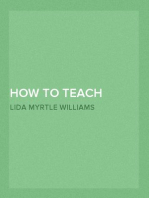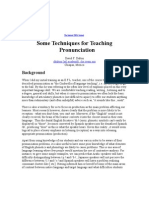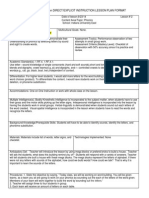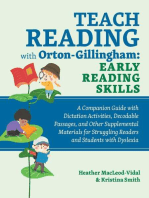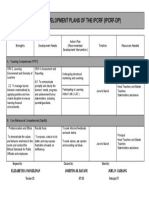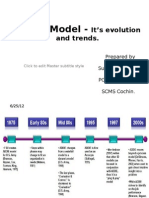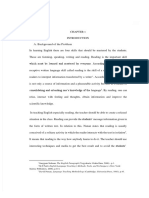Lbs 400 Lesson Plan Final
Lbs 400 Lesson Plan Final
Uploaded by
api-377552131Copyright:
Available Formats
Lbs 400 Lesson Plan Final
Lbs 400 Lesson Plan Final
Uploaded by
api-377552131Original Title
Copyright
Available Formats
Share this document
Did you find this document useful?
Is this content inappropriate?
Copyright:
Available Formats
Lbs 400 Lesson Plan Final
Lbs 400 Lesson Plan Final
Uploaded by
api-377552131Copyright:
Available Formats
Step 3
Lesson Plan - LBS 400
Candidate: Subject: ELA Grade level(s): Date: 11/15/17
Eric Galdamez 9-12
Standard: Decoding and Word Recognition
1.14 Match all consonant and short-vowel sounds to appropriate letters.
1.15 Read simple one-syllable and high-frequency words (i.e., sight words)
I. DESCRIPTION OF CONTENT & CONTENT TYPE (Fact, Procedure, Concept, or Principle):
Students will be able to recognize and pronounce words with short vowel sounds.
II. LEARNING OUTCOME (Objective):
Given that the students didnt do well on the Primary Spelling Inventory assessment, I will be teaching
them the short vowel sounds, and in the end, the students will be able to recognize and pronounce short
vowel sounds in a word.
DOK/Cognitive Rigor Level: Level 1. Students will learn how to pronounce short vowel sounds and
recognize them in 3 to 4 letter words.
Language Demands
Students will need to participate by repeated the vowel sounds after me and have to name and sound out
the vowel for every vocabulary word.
III. CURRICULUM CONNECTION (How lesson fits into larger unit sequence): Before this lesson,
students will learn the alphabet and consonants. After this lesson, students learn long vowel sounds.
IV. INSTRUCTION
A. ENGAGEMENT (Motivational Activity):
The teacher will begin by asking the students if they know their vowels. Then ask if they know how to
pronounce and identify short vowels.
Student friendly objective: By the end of our lesson you should be able to recognize and
pronounce short vowel sounds in 3 to 4 letter words.
Purpose: It is important because vowels are used in everyday language and it the first key components
to learning English.
B. INSTRUCTIONAL SEQUENCE (Teaching Methodology With Student Activities):
Step #1: Intoduction of short vowel sounds.
a. T input Before introducing the vowels, the teacher must explain that there are five vowels in
the alphabet and what makes these five letters different from consonants is that your teeth and
lips are not required to pronounce them.
a. T model Teacher will then show the students the vowel cards and begin pronouncing them
showing students how teeth and/or lips are used. Teacher will then have students try pronouncing
them.
b. Student response: Check for understanding: active participation: think pair share, choral response,
etc.
Step #2: Short vowel sounds
a. T input Teacher will now explain to the students that we will begin this lesson by sounding out
all the short vowel sounds.
a. T model Teacher will show the short vowel flashcards while saying the letter name and letter
sound and have students repeat.
b. Student response: Check for understanding: active participation: think pair share, choral response,
etc.
Step #3: Words with short vowels
a. T input Teacher will now show picture cards for the words that have short vowel sounds and
say the name of the picture, emphasizing the short vowel sound and have students repeat.
a. T model Teacher will say a/ a/ ant and have students repeat. (do this for each short vowel
sounds)
b. Student response: Check for understanding: active participation: think pair share, choral response,
etc.
Step #4: Model
a. T input Teacher will now have the student practice identifying the short vowel in the picture
cards with their own set of short vowel cards.
a. T model Teacher will hold up the picture cards and pronounce the word while students look
through their short vowel flashcards and pick up the correct card and hold it up. Teacher will
then hold up the correct flashcard so students can see if they are correct. If they are not correct,
give them time to find the correct card and have them hold it up.
b. Student response: Check for understanding: active participation: think pair share, choral response,
etc.
Step #5: Review
a. T input Teacher will now review all the short vowel sounds
a. T model Teacher will hold up the short vowel flashcards, pronounce them and have students
repeat.
b. Student response: Check for understanding: active participation: think pair share, choral response,
etc.
C. APPLICATION ACTIVITY (Practice and/or Reflection): Students will then complete a short vowel
worksheet to check for individual understanding.
D. MATERIALS & RESOURCES:
Short vowel flash cards (a,e,i,o,u)
Letter flash cards Aa-Zz
Picture cards (ant, cat, egg, bed, igloo, fish, ox, fox, up, bug, etc.)
Closing activity worksheet
V. ASSESSMENT STRATEGIES (Methods For Obtaining Evidence Of Learning):
Formative: During Lesson, Check for Understanding, Teacher observation
Summative: At the end of the lesson, students will complete a worksheet that consists of words with
missing vowels.
VI. ACCOMMODATIONS and/or MODIFICATIONS FOR INDIVIDUAL LEARNERS (Content,
Instruction, Practice): If students primary language is not English the teacher will use more visuals to
explain the words and letters. For struggling students the teacher will allow more time for the students and
check for understanding more often. For the overachievers, the teacher will provide more difficult words
with short vowels or words with multiple vowel for students to decipher.
You might also like
- Lesson Plan S SoundDocument4 pagesLesson Plan S Soundapi-489855639100% (2)
- Lesson Plan WeeblyDocument12 pagesLesson Plan Weeblyapi-281027473100% (1)
- Edtpa Silent-EDocument9 pagesEdtpa Silent-Eapi-294706400No ratings yet
- The Case of The Silent eDocument3 pagesThe Case of The Silent eapi-450830120No ratings yet
- Rhyme Lesson PlanDocument5 pagesRhyme Lesson Planapi-252920831No ratings yet
- 1st Grade Lesson Plan - Phonics Ch-Sound Macarthur ElemDocument3 pages1st Grade Lesson Plan - Phonics Ch-Sound Macarthur Elemapi-269566968100% (1)
- Sipps Lesson Week 3Document3 pagesSipps Lesson Week 3api-44869056650% (2)
- Cursul de Pregătire Pentru TitularizareDocument12 pagesCursul de Pregătire Pentru TitularizareAnonymous Wfl201YbYo100% (1)
- Lesson Plan Clasa A VI-A SalatrucelDocument7 pagesLesson Plan Clasa A VI-A SalatrucelMelania AnghelusNo ratings yet
- Cursul de Pregătire Pentru TitularizareDocument12 pagesCursul de Pregătire Pentru TitularizareAlexandra Aly Simion100% (2)
- Step 3 Lesson Plan-RevisedDocument3 pagesStep 3 Lesson Plan-Revisedapi-458596557No ratings yet
- Okabe ToolkitsDocument54 pagesOkabe Toolkitsapi-414161609No ratings yet
- Lbs Final LessonDocument4 pagesLbs Final Lessonapi-380172835No ratings yet
- Carlos Lesson Plan FinalDocument3 pagesCarlos Lesson Plan Finalapi-380176472No ratings yet
- Edpg 6 - TwsDocument21 pagesEdpg 6 - Twsapi-346196685No ratings yet
- Lbs 400 Lesson Plan FormDocument2 pagesLbs 400 Lesson Plan Formapi-331896050No ratings yet
- Lesson 1 Long VowelsDocument3 pagesLesson 1 Long Vowelsapi-271846116No ratings yet
- French 3 LessonsDocument10 pagesFrench 3 Lessonsapi-242011178No ratings yet
- Lesson Plan Form - LBS 400: Candidate: Subject: Grade Level(s) : DateDocument6 pagesLesson Plan Form - LBS 400: Candidate: Subject: Grade Level(s) : Dateapi-384805212No ratings yet
- Lbs 400 Lesson PlanDocument3 pagesLbs 400 Lesson Planapi-376965241No ratings yet
- Step 3 Lesson Plan Lbs 400Document4 pagesStep 3 Lesson Plan Lbs 400api-406727689No ratings yet
- ELA lesson plan-observation 4Document3 pagesELA lesson plan-observation 4cedes414No ratings yet
- Phonics LessonDocument5 pagesPhonics Lessonapi-645343769No ratings yet
- Some Techniques For Teaching Pronunciation: BackgroundDocument4 pagesSome Techniques For Teaching Pronunciation: BackgroundgftfhfhjhfNo ratings yet
- Reading Strategy Lesson PlanDocument4 pagesReading Strategy Lesson PlankevinleeporacanNo ratings yet
- Tier 2 Lesson Plan - U5w3Document4 pagesTier 2 Lesson Plan - U5w3api-445935606No ratings yet
- LessonplanwithtechnologyDocument15 pagesLessonplanwithtechnologyapi-255292644No ratings yet
- Some Techniques For Teaching Pronunciation: BackgroundDocument5 pagesSome Techniques For Teaching Pronunciation: Backgroundhappygirl90No ratings yet
- Lbs400lesson Plan Step3Document4 pagesLbs400lesson Plan Step3api-370979946No ratings yet
- Teaching PronounciationDocument8 pagesTeaching PronounciationmelaniacaraNo ratings yet
- CELTA Assignment 2 Focus On The LearnerDocument10 pagesCELTA Assignment 2 Focus On The Learnerjavad mohammadyNo ratings yet
- Tiếng Anh 1 - SGVDocument180 pagesTiếng Anh 1 - SGVQuang NguyễnNo ratings yet
- Reading Teacher ExamDocument43 pagesReading Teacher Examcboosalis100% (1)
- Baldwin Lesson PlanDocument3 pagesBaldwin Lesson Planapi-307117603No ratings yet
- Lesson Plan FormDocument3 pagesLesson Plan Formapi-377615055No ratings yet
- Observation Report 6 Daniel Shin Pronunciation DebbieDocument6 pagesObservation Report 6 Daniel Shin Pronunciation Debbieapi-299925043No ratings yet
- 1Document60 pages1MajddiNo ratings yet
- Principles and Directions in Teaching English (2) - 1Document104 pagesPrinciples and Directions in Teaching English (2) - 1anamaria.raduNo ratings yet
- Portfolio Lesson PlanDocument5 pagesPortfolio Lesson Planapi-434856687No ratings yet
- Lesson Plan 10 Day 1Document2 pagesLesson Plan 10 Day 1api-440838676No ratings yet
- Observation Lesson 3Document3 pagesObservation Lesson 3api-301899034No ratings yet
- LESSON PLAN Final Evaluation DidactisDocument5 pagesLESSON PLAN Final Evaluation DidactisPaola Sarmiento LozadaNo ratings yet
- Week 16Document16 pagesWeek 16Iefa KhooNo ratings yet
- Lesson Plan 2Document3 pagesLesson Plan 2api-456792359No ratings yet
- Teaching Hints For Book 2: Lane's English As A Second LanguageDocument15 pagesTeaching Hints For Book 2: Lane's English As A Second LanguageAytanGuluzadeNo ratings yet
- Lesson 2 PhonicsDocument2 pagesLesson 2 Phonicsapi-248710381100% (1)
- After reading activities.Document5 pagesAfter reading activities.nopersonal1989No ratings yet
- Flocabulary Vocabulary Lesson PlanDocument2 pagesFlocabulary Vocabulary Lesson Planapi-251038509No ratings yet
- Lesson Plan 5: Learning Outcomes Target Language SpeakingDocument6 pagesLesson Plan 5: Learning Outcomes Target Language Speakingapi-317480573No ratings yet
- Learning Plan Sir RomanDocument4 pagesLearning Plan Sir Romanarianerosearcega30No ratings yet
- METODICADocument11 pagesMETODICAIoana IonitaNo ratings yet
- Formal Lesson PlanDocument2 pagesFormal Lesson Planapi-305598552100% (1)
- 400 Lesson PlanDocument4 pages400 Lesson Planapi-403104065100% (1)
- Didactica Limbii EnglezeDocument1 pageDidactica Limbii EnglezeAnda AndaNo ratings yet
- Basic Competition Indicator: Lesson Plan (Alphabet)Document2 pagesBasic Competition Indicator: Lesson Plan (Alphabet)All ChannelNo ratings yet
- 2nd Lesson PlanDocument3 pages2nd Lesson Planapi-301899034No ratings yet
- Millicent Atkins School of Education: Common Lesson Plan TemplateDocument4 pagesMillicent Atkins School of Education: Common Lesson Plan Templateapi-405934378No ratings yet
- Phonics For KSSRDocument13 pagesPhonics For KSSRrozilarashid100% (1)
- Teach Reading with Orton-Gillingham: Early Reading Skills: A Companion Guide with Dictation Activities, Decodable Passages, and Other Supplemental Materials for Struggling Readers and Students with DyslexiaFrom EverandTeach Reading with Orton-Gillingham: Early Reading Skills: A Companion Guide with Dictation Activities, Decodable Passages, and Other Supplemental Materials for Struggling Readers and Students with DyslexiaNo ratings yet
- Development Plan BlankDocument1 pageDevelopment Plan BlankJoel Briones100% (2)
- AddieDocument30 pagesAddieKrishna SumanthNo ratings yet
- HistoryoftheHumanSciences 2015 Daniels 34 50Document18 pagesHistoryoftheHumanSciences 2015 Daniels 34 50Danny CrisNo ratings yet
- Advantages and Disadvantages of ESL Course Books Copy ArtikelDocument8 pagesAdvantages and Disadvantages of ESL Course Books Copy ArtikelNurmalasariNo ratings yet
- 1 Focus 4 Lesson PlanDocument2 pages1 Focus 4 Lesson PlanMarija TrninkovaNo ratings yet
- Relgion Lesson Plan 2Document5 pagesRelgion Lesson Plan 2api-313599773No ratings yet
- Nicolette Teles ResumeDocument1 pageNicolette Teles Resumeapi-513528749No ratings yet
- Visualizing VerbalizingDocument3 pagesVisualizing Verbalizingapi-243039417No ratings yet
- Assessing The Curriculum: Linking Curriculum, Instruction and Assessment (CIA) : Making A FitDocument19 pagesAssessing The Curriculum: Linking Curriculum, Instruction and Assessment (CIA) : Making A FitJessa Mine Bulawit BracamonteNo ratings yet
- TEACHERDocument6 pagesTEACHERchris layNo ratings yet
- Computer U1 L2 Lesson Plan Grade 1Document1 pageComputer U1 L2 Lesson Plan Grade 1Munira NasserNo ratings yet
- Scholarship ApplicationsDocument2 pagesScholarship Applicationsapi-371068687No ratings yet
- SBELC KSSR Explanation 2018Document44 pagesSBELC KSSR Explanation 2018Chammaks TilloNo ratings yet
- Internship QuestionnaireDocument2 pagesInternship QuestionnaireJoão Victor Santos da SilvaNo ratings yet
- Lesson Plan Grammar Reflexive PronounDocument3 pagesLesson Plan Grammar Reflexive PronounNana71% (7)
- Drexel Lesson PlanDocument4 pagesDrexel Lesson PlanMia mooreNo ratings yet
- Indicators of Quality in EducationDocument4 pagesIndicators of Quality in EducationAmmar Saleem86% (7)
- Final Demonstration Observation/Evaluation Checklist: A. Teacher'S PersonalityDocument2 pagesFinal Demonstration Observation/Evaluation Checklist: A. Teacher'S PersonalityNowiean ExitNo ratings yet
- Adjectives Lesson PlanDocument4 pagesAdjectives Lesson Planapi-349980598No ratings yet
- CTET Coaching in Delhi, CTET Coaching Institute in DelhiDocument16 pagesCTET Coaching in Delhi, CTET Coaching Institute in DelhiCompetition GurukulNo ratings yet
- Sorting Lesson PlanDocument4 pagesSorting Lesson Planapi-267077176No ratings yet
- Clinical Practice Evaluation 4 Encrypted 1Document89 pagesClinical Practice Evaluation 4 Encrypted 1api-395293183No ratings yet
- Annotation Template For Teacher I IiiDocument1 pageAnnotation Template For Teacher I IiiARIEL JAY CHICONo ratings yet
- (PDF) Chapter 1Document5 pages(PDF) Chapter 1sea worldNo ratings yet
- SS27Document1 pageSS27locklaim cardinozaNo ratings yet
- Letter of Intro 2019Document3 pagesLetter of Intro 2019api-276046437No ratings yet
- Zachary Jung - Lesson Plan Template - 2801576Document4 pagesZachary Jung - Lesson Plan Template - 2801576api-513118396No ratings yet
- Midwifery 11-2013 Room AssignmentDocument21 pagesMidwifery 11-2013 Room AssignmentPRC BaguioNo ratings yet
- DLL Demo TeachingDocument4 pagesDLL Demo TeachingAngelo Morcilla TiquioNo ratings yet
- B.Ed. First Semester (C.B.S.) Examination Perspectives in Psychology of Teaching, Learning and Development CompulsoryDocument3 pagesB.Ed. First Semester (C.B.S.) Examination Perspectives in Psychology of Teaching, Learning and Development CompulsoryVarunNo ratings yet










